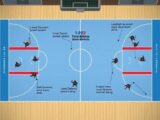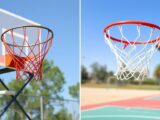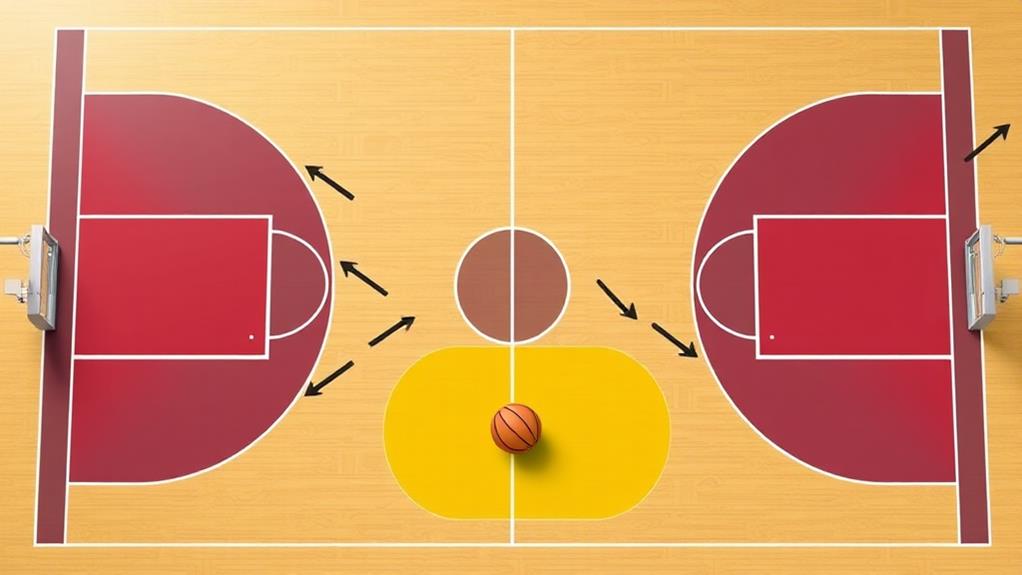
A Step-by-Step Guide to Coaching the 2-3 Zone Defense
September 20, 2024Coaching the 2-3 zone defense means mastering its structure and principles to keep your opponents from scoring. Start by positioning two guards at the top and three players near the basket. Focus on effective communication to maintain defensive responsibilities and cover passing lanes. Emphasize the importance of closing out on shooters and providing help defense. Adjust your strategies based on your opponents' strengths and weaknesses. Don't forget about trapping opportunities and collective rebounding efforts. As your team becomes more cohesive, you'll see improvements in your defensive play. Stick around, and you'll discover advanced techniques for even better results.
Overview of the 2-3 Zone Defense
When you immerse yourself in the 2-3 zone defense, you'll notice it's all about area coverage rather than man-to-man matchups. This structure features two guards stationed at the top of the key and three players—two forwards and a center—near the basket. Your primary focus here is paint protection, as having three players close to the rim deters drives and limits easy scoring opportunities for opponents.
Mastering defensive positioning is vital, as it allows players to anticipate opponent movements and cut off passing lanes effectively. Effective communication is essential in the 2-3 zone. As the ball moves, players must adjust their positioning to cover passing lanes and maintain defensive responsibility.
This defense is particularly advantageous against teams that rely on inside scoring, as it emphasizes controlling key areas near the basket and disrupting offensive plays. Understanding man-to-man defense principles can aid your shift to the 2-3 zone, as it helps you grasp spacing and positioning.
Advantages of the 2-3 Zone
The 2-3 zone offers strong defensive stability by placing three players near the basket, which effectively guards against inside scoring.
This setup not only protects the paint but also creates opportunities for your team to force turnovers and rushed shots from opponents. By utilizing this defense, you can disrupt your opponent's rhythm and control the pace of the game.
Additionally, maintaining proper spacing within the zone prevents vulnerabilities and guarantees better coverage of passing lanes, further enhancing defensive effectiveness.
Defensive Stability and Coverage
One of the key advantages of the 2-3 zone defense is its ability to create defensive stability and coverage, particularly in protecting the paint. By positioning three players near the basket, you greatly reduce easy scoring opportunities from drives and layups. This setup often catches offensive players off guard, as many teams primarily practice against man-to-man defenses, leading to increased turnovers and rushed shots.
Effective team communication is essential in the 2-3 zone. By working together, players enhance overall defensive coverage, ensuring that gaps are minimized, and responsibilities are clear. This cohesion not only fosters defensive stability but also allows you to control the tempo of the game. You can adjust your aggressiveness in trapping or settle into a more patient setup based on your opponent's strengths.
Moreover, the 2-3 zone naturally limits aggressive play, reducing fouls, which is beneficial if you struggle with foul trouble. With smart player positioning, you'll maintain key players on the court longer, allowing your team to stay competitive throughout the game.
Embracing these advantages makes the 2-3 zone an effective defensive strategy.
Effective Against Inside Scoring
Effective inside scoring is often thwarted by the strategic layout of the 2-3 zone defense. This formation keeps three players close to the basket, effectively guarding the paint and minimizing easy layup opportunities. By positioning a center in the low post, you deter drives and force opponents to take contested shots, which can disrupt their offensive strategies.
With two guards stationed at the top, your zone defense can effectively contest high post entries and disrupt passing lanes, further limiting threats to inside scoring. This structure not only pressures the ball but also encourages the opposing team to make hasty decisions, leading to rushed and poorly executed shots.
Additionally, the natural spacing of the 2-3 allows for excellent help defense. Your players can quickly shift to provide support when an opponent drives toward the basket, ensuring they're always in a solid defensive position.
This approach makes it challenging for teams that rely on inside scoring to find rhythm, forcing them to adapt or struggle under pressure. In effect, the 2-3 zone not only protects the paint but also reshapes how opponents attack your defense.
Weaknesses of the 2-3 Zone
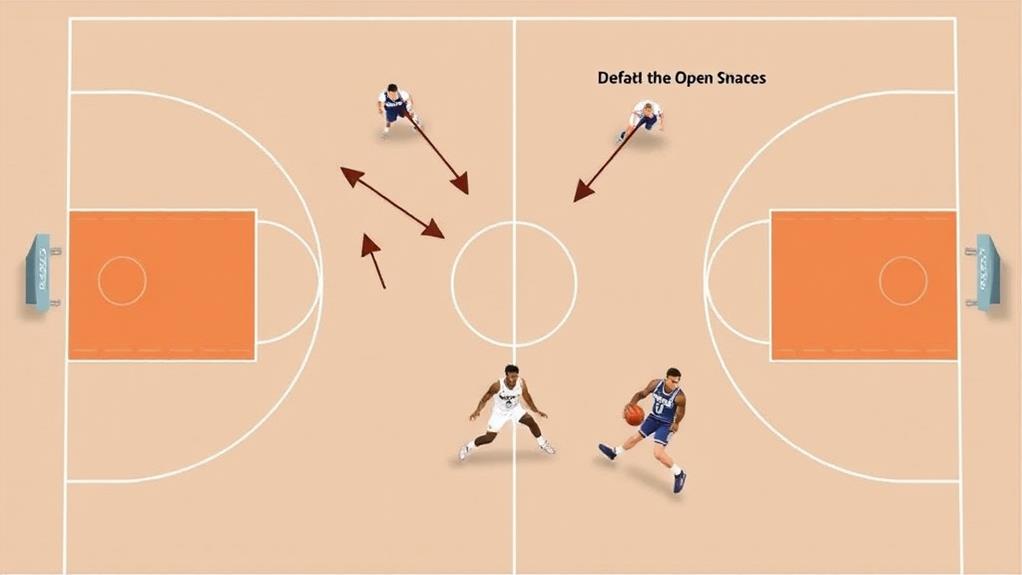
Many coaches find the 2-3 zone defense has notable weaknesses that can be exploited by savvy offenses. One major vulnerability is its susceptibility to outside shooting. If your defenders don't close out effectively, opponents can capitalize on open perimeter shots.
Additionally, rebounding becomes a challenge since the 2-3 zone lacks specific matchups. This can lead to players being boxed out, resulting in offensive rebounds for the opposing team. To enhance your team's performance in the zone, utilizing data-driven strategies can help identify effective combinations that mitigate these vulnerabilities.
Mismatches are another concern. Offenses can easily target players who are less skilled or slower, creating easy scoring opportunities. Your team's effectiveness in this zone diminishes greatly when playing from behind, as opponents can manipulate the shot clock to limit your defense's impact.
Communication and teamwork are essential to mitigate these weaknesses. A lapse in cohesion can create coverage gaps, leading to uncontested scoring chances. To maintain the integrity of the 2-3 zone, you need to emphasize the importance of alertness and collaboration among your players.
Implementation Strategies
To effectively implement the 2-3 zone defense, you need to focus on defensive positioning techniques that allow players to cover their areas efficiently.
This approach mirrors the importance of effective communication and formations in team sports, which helps clarify roles and responsibilities.
Communication and coordination among your team are vital, so encourage players to vocalize their movements and assignments.
As offenses adapt, it's essential for your players to adjust their strategies, ensuring they stay one step ahead of the competition.
Defensive Positioning Techniques
Mastering defensive positioning in a 2-3 zone defense can make all the difference in your team's performance. Start by guaranteeing your two guards are positioned at the high elbows to apply pressure on the ball and prevent easy passes into the high post area.
The ball-side forward (3) needs to be ready to close out on shooters while also being prepared to help defend against drives to the basket. Your weak-side forward (4) should position themselves up the lane to intercept skip passes and assist in any necessary defensive rotations.
The center (5) plays an essential role by fronting the low post player and being ready to contest shots or provide help on drives into the paint.
It's critical to emphasize effective communication among players; guarantee they call out screens and adjust their positioning based on ball movement. This way, each player stays aware of their responsibilities and can quickly react to offensive threats.
Communication and Coordination
Effective communication is the backbone of a successful 2-3 zone defense. To guarantee your players effectively coordinate their movements, it's essential to establish a system of verbal cues and hand signals. This way, they can call out screens, switch assignments, and alert teammates about offensive movements.
During defensive rotations, maintaining clear communication helps everyone stay aware of their responsibilities.
In your practice sessions, incorporate drills that emphasize communication skills. Create scenarios where players must vocalize their actions while maintaining defensive integrity. Encourage them to maintain eye contact with one another, fostering teamwork and reinforcing the importance of being aware of each other's positions and movements.
Proactive communication is significant in anticipating offensive actions. Teach your players to relay information about potential gaps in the defense before the offense can exploit them. This anticipation allows them to adjust their strategies quickly.
Adjusting to Offenses
Adjusting your 2-3 zone defense in response to offensive strategies is essential for maintaining control of the game. Start by analyzing the opponent's shooting capabilities. If they excel at shooting from the perimeter, close out more aggressively to mitigate outside threats.
Utilize traps effectively by focusing on ball movement patterns. Deploy traps at the wings and corners to force turnovers and disrupt their offensive flow.
Next, adjust the positioning of your players based on the opposing team's formation. Be ready for high post entries or baseline cuts, ensuring your guards and forwards are prepared.
Throughout the game, monitor how well your zone defense is holding up. If the opposing team begins exploiting specific weaknesses, make real-time adjustments to player responsibilities.
Lastly, encourage constant communication among your players. They need to quickly identify and react to offensive overloads or mismatches.
Reinforce the importance of shifting defensive responsibilities to maintain coverage. By actively adjusting your zone defense, you'll keep the offense on their toes and enhance your chances of winning the game.
Key Principles and Rules
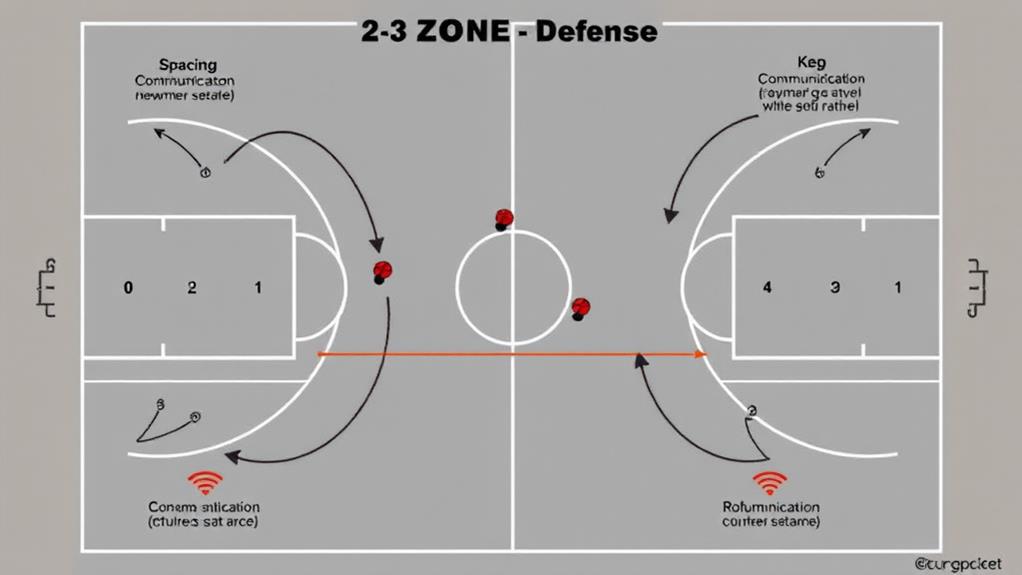
Understanding the key principles and rules of the 2-3 zone defense is essential for achieving defensive success on the court. To effectively implement this strategy, keep these principles in mind:
- Active Hands: Always keep your hands up to disrupt passing lanes. This strategy is similar to how maintaining core strength improves balance and stability in soccer, as both require a solid foundation for effective performance.
- Movement on Ball Flight: Shift your position as the ball travels to prepare for the next move. Quick adjustments are vital, akin to the agility needed in agility and coordination workouts for soccer players.
- Communication: Regularly call out screens, switches, and assignments to maintain team cohesion.
- No Layups: Prioritize preventing easy scoring opportunities, especially layups.
Defensive Positions and Responsibilities
In a 2-3 zone defense, each player's position comes with specific responsibilities that are vital for maintaining a strong defensive stance. The two guards (positions 1 and 2) are your first line of defense, pressuring the ball and covering the top of the key. Their main focus is to prevent passes to the high post and contest outside shots. To enhance their effectiveness, players should master defensive stance drills that emphasize body positioning and quick reactions.
The three forwards (positions 3, 4, and 5) protect the paint. The center (position 5) guards the low post, contesting shots near the basket. The ball-side forward (position 3) needs to be ready to close out on shooters and support the on-ball defender.
Meanwhile, the weak-side forward (position 4) monitors weak-side action and is prepared to help when necessary.
When the ball is in the corner, the ball-side forward must apply pressure while the center fronts the low post player to prevent easy entry passes. Effective communication among players is essential; they should inform each other of screens, switches, and assignments.
This guarantees defensive integrity and cohesion within the 2-3 zone defense, allowing you to maintain pressure and control the game.
Trapping Techniques and Strategies
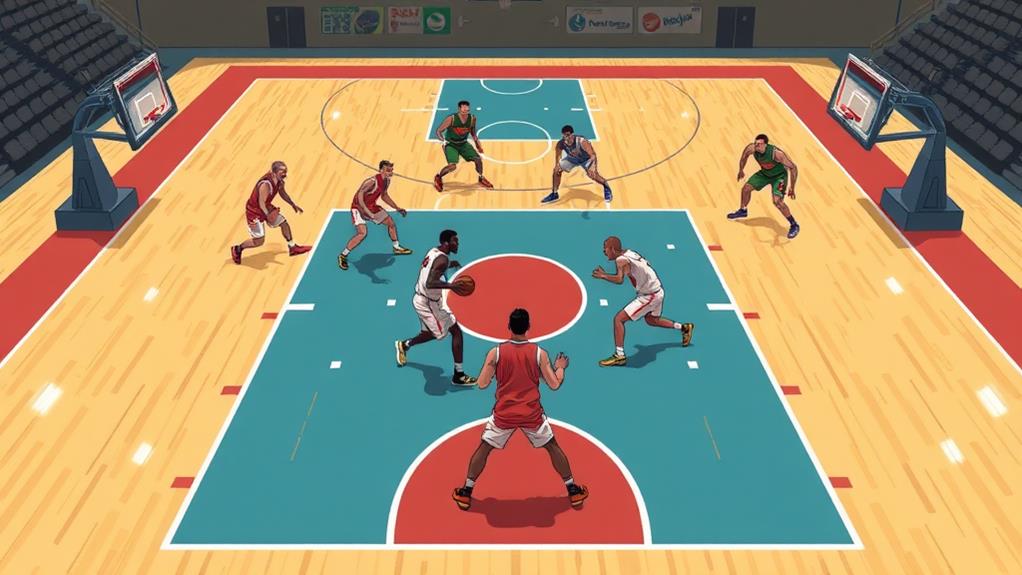
Trapping techniques in the 2-3 zone defense can be game-changers, creating opportunities for turnovers and disrupting the opposing team's rhythm. To maximize the effectiveness of your traps, focus on these key strategies:
- Target the wings and corners: These areas are ideal for trapping the ball handler, as they limit their passing options and force mistakes. Incorporating quality training sessions will enhance your players' ability to execute these traps more effectively.
- Coordinate movements: Guarantee that the ball-side forward and guard work together to close in on the trap.
- Communicate effectively: Players must call out traps and cover their responsibilities to avoid breakdowns in defense.
- Practice timing: Players need to anticipate passes and converge quickly when the ball enters the trapping zone.
When executing a trap, the center should position themselves to front the low post player for added support.
Timing is vital; as soon as the offensive team makes a pass to the wing, players should close in to apply pressure. This coordinated effort can force the ball handler into a difficult situation, resulting in turnovers.
Consistently practicing these trapping techniques will help your players develop the skills needed to execute under pressure, enhancing your team's overall defensive strategy.
Rebounding in the 2-3 Zone
Rebounding in the 2-3 zone defense hinges on a collective effort from all players, especially the three stationed near the basket. Your forwards and center must take ownership of their responsibilities by boxing out opponents on their respective sides of the hoop. This means adopting a mindset of "every rebound is yours" and pursuing the ball aggressively.
As the game evolves, the importance of strong rebounding techniques becomes even more pronounced due to the ongoing refinements necessary in defensive strategies that adapt to offensive threats.
Don't underestimate the importance of guards in this system. They need to contribute by boxing out offensive players and being ready to secure loose balls outside their designated areas. By emphasizing proper boxing out techniques in practice, you cultivate a habit that minimizes second-chance opportunities for the offense.
Make sure all players are aware of their roles, especially when it comes to adapting your rebounding strategy based on the opposing team's size and skill level. Encourage your players to communicate with their teammates during these box-out situations.
Together, you'll create a more effective rebounding unit in your zone defense. Remember, successful rebounding is a team effort that requires everyone to stay engaged and focused on the task at hand.
Conclusion
To sum up, mastering the 2-3 zone defense can be like orchestrating a symphony, where every player plays a crucial note in creating harmony on the court. By understanding its advantages and weaknesses, implementing effective strategies, and instilling key principles, you'll empower your team to excel defensively. Remember, consistent practice and communication are key to success. So get out there, fine-tune your defense, and watch your players thrive as they work together to protect the basket.

